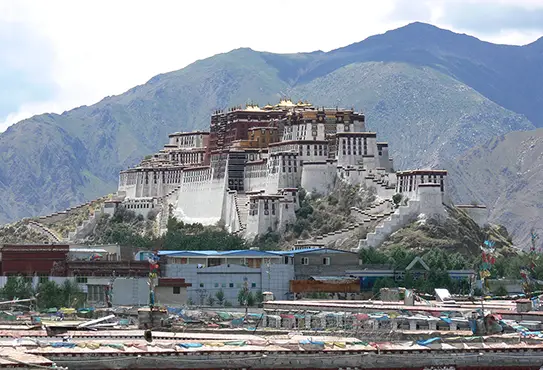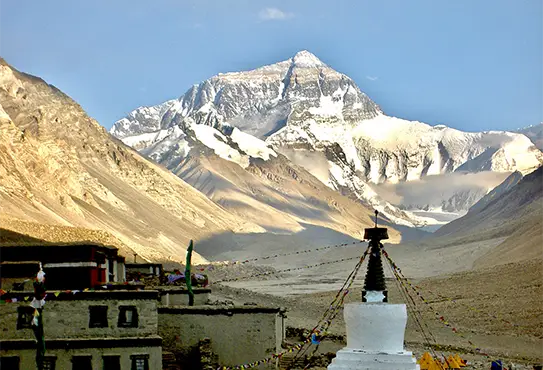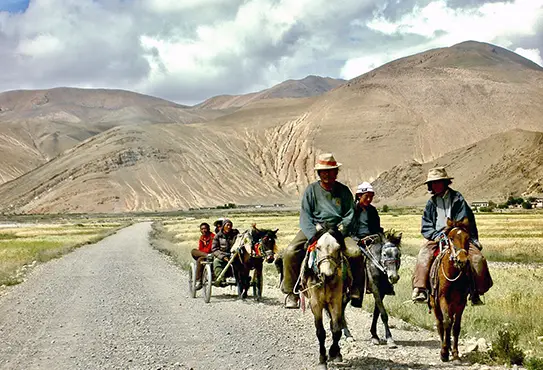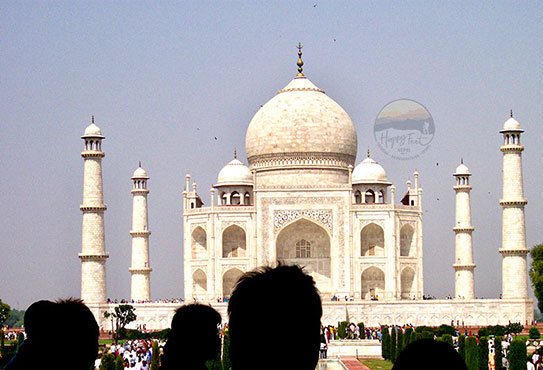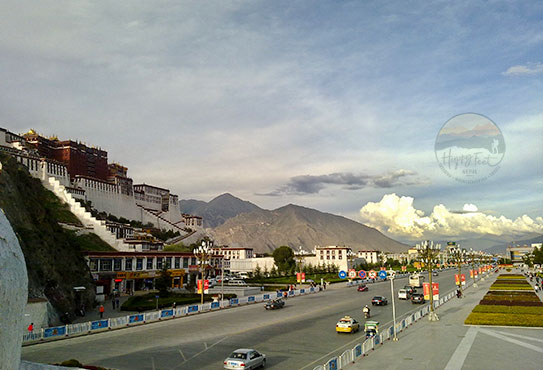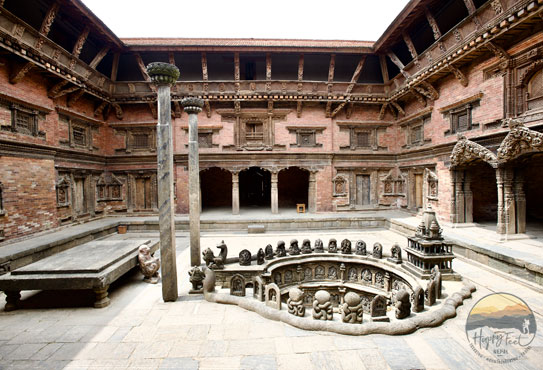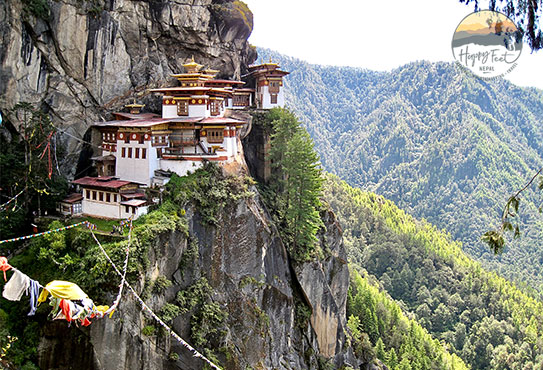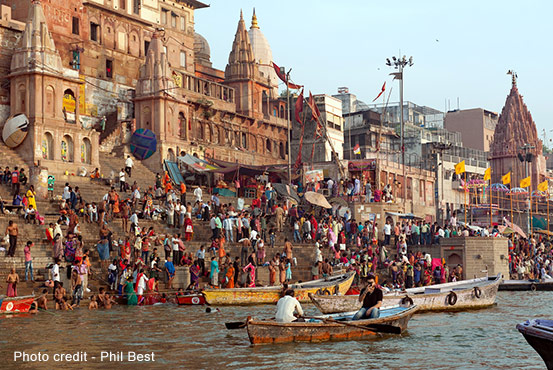-
Sunday - Friday: 9 AM - 4 PM
From the plains of Terai to the Land of Gods, Lhasa City, and the Base camp of Mount Everest, just in 17 days.
Nepal and Tibet Tour includes visits to Kathmandu Valley, Pokhara City, a Jungle safari in Chitwan National Park, and Tibet’s most important sites.
Tour of Nepal visiting Kathmandu and the monuments surrounding the Kathmandu Valley, listed in the World Heritage Sites by UNESCO. Next, visit Pokhara, in front of the Annapurna massif and the Chitwan National Park, one of Asia’s most important natural parks. Then we fly to Tibet, the roof of the World with incredible landscapes and wonder-filled histories of Buddhism. In Tibet, we visit the Buddhist monasteries and temples, their cities and typical Tibetan villages and the base camp of Mount Everest, the North Face.
Arrive in Kathmandu, customs and immigration formalities and claim your baggage, which takes some time. Upon exiting, the arrivals get a traditional welcome from the Happy Feet Nepal representative and transfer to the hotel. Reach the hotel and the rest of the day is free with the possibility of optional excursions (not included), but you can ask to organise any of the tours or stroll through its vibrant streets.
Kathmandu, the capital and heart of the country with three medieval cities, symbolises Nepal’s everything. Having lived through the several ruling dynasties of Buddhists and Hindus, the culture and society of Kathmandu Valley have evolved through time to give it more than a unique feature. Today it is an urban city, and still rapidly increasing, that has its ancient myths and, at the same time, is testimony to the greatness of people who have lived there for time immemorial.
Accommodation in Hotel Shanker, a 4-star hotel.
Breakfast at the hotel. In the morning, visit Swayambhunath, dating back more than 25 centuries, and so one of the world’s oldest Buddhist chaityas; the great stupa of Swayambhunath is a landmark wonder of Nepal and listed as a World Heritage Site. The all-seeing eyes of Lord Buddha keep an eternal watch over the valley.
Swayambhu is located west of Kathmandu proper on a hillock about 500 feet above the valley floor. The hill is a mosaic of small chaityas and pagodas—one Hinayana (Theravada) and five Mahayana (Vajrayana)—temples. The site offers a complete view of Kathmandu Valley, its surroundings, and the northeastern Himalayas.
In continuity, drive to Patan, one of the three medieval cities of Kathmandu Valley and one of the World Heritage sites among the seven World Heritage sites of Kathmandu Valley, located 7-kilometres southwest of Kathmandu. The city known as Lalitpur, the City of Arts, was a renowned Buddhist centre in Asia and has four Ashoka-built Stupas and a multitude of miniature stupas, monasteries, viharas and temples. At Patan, we visit its Durbar Square, the Golden Temple, Thousand Buddha, and its museum, among other sites, which explain Buddhism and Hinduism in extensive labels within the living traditions and context.
In the afternoon, drive to Basantapur Durbar Square, also known as Kathmandu’s Durbar Square. The tour of the Kathmandu Durbar Square, classified as a World Heritage Site, teems with activity. It features countless monuments, including the House of the Living Goddess (Kumari Ghar) and the ferocious Kal Bhairab and kneeling Hanuman (the red-capped monkey god) statues.
The architecture represents some of the greatest achievements of the medieval Malla era. The stroll leads around the square past a host of pagoda temples (including the grand temple of the goddess Taleju) and a window framing Shiva and Parbati sitting together viewing the scene.
The square is full of colourful life centred on the Kasthamandap rest-house. Said to have been built with wood from a single tree (and the origin of Kathmandu’s name), it is now reconstructed in the wake of the 2015 earthquake. Then visit the Temple of Kumari; the residential quarters of the Living Goddess called Kumari (‘chaste virgin’) consists of a traditional building complex featuring carved wooden balconies and windows.
Also impossible to overlook are the great bell and large drums. The palace’s main golden gate is guarded by the monkey god Hanuman, the faithful devotee of Lord Ramachandra, the hero of the epic Ramayana.
Finally, pass through the Hanuman Doka: the historic seat of the past Malla and Shah dynasties. The historic temples and palaces epitomise the religious and cultural lifestyle of the rulers. Among the most interesting things to view is the Taleju Temple, built by King Mahindra Malla in A.D. 1549 and a historical museum containing artefacts of past Shah kings.
We finalise with the tour and ride a rickshaw and roll through its old city market centre, the Ason Bazaar, seeing what the Nepalese people buy and sell in their daily run.
Accommodation in Hotel Shanker, a 4-star hotel (breakfast included).
Breakfast at the hotel and drive to Pashupatinath Temple. A Hindu pagoda temple with gilt roofs carved with silver doors dedicated to Lord Shiva, situated at the bank of the holy Bagmati River and regarded as among the most sacred temples of the Hindu religion, Pashupatinath is the focus of pilgrimages culminating in the day of Shiva Ratri (the marriage anniversary of Lord Shiva and the goddess Parvati). Pashupati is also the cremation ground in the ghats (cremation group) along the bank of River Bagmati, where the recently deceased Hindus of the Valley are cremated.
Then visit the Boudhanath, the largest Buddhist shrine in South Asia. This ancient Chorten was built in the 5th century A.D. by King Manadeva. A series of three terraces lead up through water, fire and air segments to the pinnacle, symbolic of space and the highest spiritual attainment. The whole is surrounded by a circle of shops which form a small Tibet. Lord Buddha’s four pairs of eyes flash vividly into the cardinal directions, radiating the message of Mahayana Buddhism, which is known as Lamaism in Sikkim, Ladakh, Bhutan and Tibet.
Then we take a 13-kilometres drive to Bhaktapur, east of Kathmandu. Its original name is, Bhadgaon, or the village of Devotees is one of the living museums of Kathmandu Valley. Bhaktapur is filled with the 55-windowed Royal Palace, the Palace of the Kumari, the temple of Taleju, the temple of Pashupati, the main square of Taumadhi Tole, Nyatapola Temple (the most imposing the tallest such architecture in all of Nepal), the temple of Akash Bhairab (the second most important temple of Bhadgaon), the Dha Hateya and the Square of the Potters. UNESCO recognises Bhaktapur as a World Heritage Site.
After the visit, we leave by road in the direction of Nagarkot, at an altitude of 2,100m and 32 kilometres east of Kathmandu or 19 kilometres northeast of Bhaktapur. Nagarkot is one of the most beautiful hill resort areas to enjoy seeing sunrises and views of the Mountain Range, from the Langtang to Everest.
Accommodation at the Club Himalaya, a 4-star hotel, breakfast included.
210km – 6hrs drive.
Sunrise view tour. Breakfast at the hotel and departure by road to Pokhara, located 200 kilometres west of Kathmandu, is the third-largest city in the country. Due to its location, the temperature is always warmer than in Kathmandu. The driving takes you through an exciting highway of the country overlooking mountains and hills and scattered villages until we reach Pokhara. The Annapurna, Machhapuchhre Himal, and Lamjung rim the northeastern horizons of the town.
Accommodation in Temple Tree, a 4-star deluxe hotel (breakfast included).
Breakfast at the hotel and transfer 13-kilometres to Pumdikot, a strategic hill with an ancient fort in ruins and recently converted into a Shiva temple; it is a beautiful viewpoint. The views of Annapurna, Pokhara and the peace stupa are beyond description. From Pumdikot, we take a scenic drive to Peace Stupa, enjoying magnificent views of Phewa Lake, the Himalayas, Pokhara City and its surroundings. The Peace Stupa site is equally beautiful, with splendid views.
The World Peace Stupa stands gloriously on a hill saddle above Phewa Lake and Pokhara City from where you get panoramic views of Phewa Lake, the city of Pokhara and Mount Annapurna and Lamjung (on a clear day). A Peace Stupa is a Buddhist monument to inspire peace in all races and creeds and to help unite them in their quest for world peace. Most of them were built since World War II under the direction of Nichidatsu Fujii (1885-1985), a Buddhist monk from Japan and founder of the Nipponzan-Myohoji Buddhist Order. In 1947, he started the construction of peace pagodas as world peace shrines, and in the year 2000, there were eighty Peace Pagodas built around the world between Europe, Asia and the United States.
Enjoy the landscapes of the site, visit the stupa, explore, go down to the lake shore, cross the lake by little boat, have a late lunch and visit the International Mountain Museum in Pokhara, where we will see and better understand the history of the mountain and mountaineering on the highest peaks in the world. We will understand the importance of the Himalayas of Nepal and the benefits that the Himalayas give to the millions of people and their natural habitat. After the visit, return to the shore of the lake for free time.
Accommodation in Temple Tree, a 4-star deluxe hotel (breakfast included).
165km -5hrs drive.
Early in the dawn, sunrise view tour to Sarangkot viewpoint. Sarangkot, the most famous lookout in Pokhara, offers a grand panorama of the Annapurna ranges, Machhapuchare, Manaslu, LamjungHimal, and Dhaulagiri ranges. From the Sarangkot lookout, you can also see the beautiful view of Pokhara Valley and its unique landscapes with Lake Phewa, Lake Begnas and Lake Rupa. A short 25-minute drive from the hotel in Pokhara lakeside puts you on Sarangkot, which offers a striking view of sunrise and a platform for Paragliding. Finalise the tour and drive back to the hotel for breakfast.
Then continue the drive to Chitwan National Park for a two-night and three-day safari program. Chitwan is the best national park in Asia, with an area of 967 km2 and 200km south of Kathmandu in the Terai floodplain formed by the Narayani and Rapti rivers system. This park is well known for wildlife preservation. Arrive at to resort and check in and have lunch. In the afternoon, visit the Tharu Village for a sunset view tour. At night Tharu Culture Show.
Dinner and accommodation at the Barahi Jungle Lodge, a 4-star resort (full board).
Full day in the park with different activities included, such as a safari on the elephant back exploring the fauna and flora, highlighting the one-horned rhinoceros, deer, monkeys, wild boars, bison, bears, leopards and hopefully the Bengal tiger. In this area, there are 276 species of birds out of a total of 519, which makes it a true paradise for bird watchers. We will also do a canoe excursion on the Rapti River and visit the elephant area—lunch at the resort. In the afternoon, nature walk trip.
Dinner and accommodation at the Barahi Jungle Lodge, a 4-star resort (full board).
180km -6hrs drive.
Early morning nature walking—breakfast at the resort and departure by road to Kathmandu. Sightseeing driving takes you through the plains of Terai and ascends slowly to the hill and then into the valley of Kathmandu. Finally, arrive and transfer to the hotel. The rest of the day remains for leisure on your own.
Accommodation in Hotel Shanker, a 4-star hotel (breakfast included).
90km -1hrs drive.
Sunrise view tour. Breakfast at the hotel and departure by road to Kathmandu airport to fly to Lhasa.
This one-hour trans-Himalayan flight will allow you to have an aerial view of the Mt. Everest and other Himalayan peaks. We’ll arrive at Gonggar airport at around 1.30 p.m., local time. After clearing immigration and customs, it will be a one hour drive to cover the 90 Kilometres to Lhasa. Arrive at Lhasa and check into your hotel. The rest of the time is to
Lhasa, the capital of the Tibet Autonomous Region, is located between 290 36’N and 190 06’E at the north bank of Kyichu river, a tributary of the Yarlung Tsangpo river, at an altitude of 3650 meters above the sea level. The Lhasa has a history of more than 1300 years and has been the centre of politics, economy, culture, and religion in Tibet since ancient times. “Lhasa” in Tibetan means “the land of Gods”. In Lhasa, there is a plentiful of scenic spots and historical attractions, among which Potala Palace, a thirteen-story, 1000 room Palace of the Dalai Lama, Norbulingka, the summer Palace of the Dalai Lama, Drepung Monastery, Sera Monastery, Jokhang Temple, the holiest shrine of Tibet, and the famous Ramoche temple.
Hotel accommodation in Autumn Spring Full Oxygen, breakfast included.
Breakfast in the hotel and a full day of visits. We start with the Jokhang, the religious and geographical centre of Lhasa and the most important temple for all the sects of Tibetan Buddhism. Pilgrims from all parts of Tibet flock to Lhasa to see the Jokhang at least once. They queue to enter the temple and make a ritual circuit through the dark halls, filled with the sounds of chanting and lit only by butter lamps. The main image worshipped is Jowo Rinpoche, a golden statue of Shakyamuni Buddha. There is an admiring view of Lhasa. Barkhor and Potala Palace from the rooftop of Jokhang. Then continues to Drepung Monastery, which once had 10,000 monks in residence. Drepung and Sera suffered damages during the destructive Cultural Revolution but have now been restored, and the monks have returned in smaller numbers.
In the afternoon, visit Barkhor Square, which surrounds the Jokhang with 800m of narrow streets used as a sacred route for the ritual circuit and as a bazaar (the largest in Tibet). Four huge prayer flags poles stand in each corner of Barker Square, known as JuyakDharchen in the west, Shar KyaringDharchen in the southeast, KelsangDharchen in the southwest and GadhenDharchen in the northeast. The Tibetans go clockwise around the centre during the night and day, earning religious merit, shopping, and chatting with friends. The Barkhor is the true heart of Tibet and is a lifetime experience of seeing and mingling with all sorts of people.
Hotel accommodation in Autumn Spring Full Oxygen, breakfast included.
Breakfast in the hotel and a full-day visit. Breakfast and pay a visit to the Jokhang Temple, situated in the centre of the old section of Lhasa called Barkhor, was built in the mid-7thcentury AD. It was extended later by successive rulers and has now become a gigantic architecture complex. Located in the east, and facing the west, Jokhang is a four-storeyed temple with splendid golden roofs. Its architecture features art from the Tang Dynasty but also assimilated many features from both Nepalese and Indian Buddhist temples. The murals in the temple depict the life stories of historical and religious characters. The temple houses many ancient relics, including statues of King Shrongtsen Gompo, Princess Wencheng, Princess Brikuti Devi (Nepalese). Princess willow (a tree), and the Uncle–nephew Alliance Tablet. Jokhang is Tibet’s spiritual centre and the holiest destination for Tibetan Buddhist pilgrims. It contained a sitting statue of Sakyamuni when he was 12 years old.
We then continue to Potala Palace, one of the most famous architectural works of the Tibetan World, sits on top of the red hills in Lhasa. It was built in the 7th century after the Tibetan King Shrongtsen Gampo married Princess Wencheng of the Tang court. The Palace was built to provide a court with a place of worship and meditation. In the mid 17th century, it was rebuilt by the 5th Dalai Lama to its present size and became the winter Palace of the Dalai Lamas. The construction took fifty years from beginning to completion.
The Potala Palace is divided into two sections, namely, the red Palace and White Palace. The total height of the Potala is 117 meters spanning thirteen stories. The length of the Palace from east to west is 400 meters, and the breadth from south to north is 350 meters. The building was constructed with stone and timber with golden roofs. It is a majestic architectural masterpiece.
In the evening we visit Barkhor Street, the holiest pilgrimage site in Lhasa, with innumerable shops, and wayside peddlers intermingle with devotees walking clockwise around the Jokhang. There are four huge prayer flags in each corner of Bhakor square, known respectively as Gadhen Dharchen in the northeast, Juyak Dharchen in the west, Kelsang Dharchen in the southwest and Shar Kyaring Dharchen in the southeast. An evening walk (Kora) around the Jokhang Temple, together with the Tibetan pilgrims is a lifetime experience.
Hotel accommodation in Four Points by Sheraton Lhasa, breakfast included.
355km -8hrs drive.
A full day of drive on the plains of Tibet passes through high mountain passes such as the Karo La 5010m, Tibetan villages and Lake Yamdrok. Yamdrok is a huge and wonderful lake with 624 square kilometres, and it takes almost 2 hours to cross. Finally, crossing the lake, we arrive at the village of Nagartse, where we stop for lunch. Depending on our arrival time, there is a possibility of visiting the Samding monastery, one of the famous nunneries in Tibet.
After lunch, drive to Gyantse, a big town between the monastery and the Gyantse fortress. Gyantse is famous for its cultivation due to its fertile land and Kubum Stupa. Upon arrival, we will visit the Kubum stupa and the Palchoe monastery. PhalkorChoide Chorten: This unique structure, built in 1414, comprises five stories representing the five steps to enlightenment and is soared by thirteen rings that symbolize the stages of advancement toward Buddhahood. There are 108 rooms inside, each with frescoes and Buddha Shrines. Phalkor Monastery was founded by Je Kedup of the Gelugpa sect and KunsangRabten of the Sakyapa sect in 1418. The monastery has a particular influence on Tibetan Buddhism due to its unification of the three different sects, the Gelugpa, Sakyapa and Bhuton sects, in a single monastery. The famous Kubum Pagoda, built in collaboration with Newari artists from Nepal and Tibet artists, is located in the same courtyard, with nine stories, 108 gates and 77 shrines containing various murals and clay sculptures. The Kubum pagoda is said to have 100,000 images (Bum in Tibetan), either carved or painted, and this is the reason for its name, “100,000 pagoda images”.
Finish the visit and then continue the road to Shigatse, the second-largest city in Tibet, located 320 kilometres west of Lhasa and 90 kilometres from Gyantse. Shigatse lies between 290 02 ‘N and 08’E 880 in the southwest of the Tibet Autonomous Region, where the Nyangchu River meets the Yarlung Tsangpo River. Shigatse is the second-largest city in Tibet and is the transportation and distribution centre for agricultural and livestock products in the southeastern part of Tibet. Arrive in Shigatse and check into the hotel.
Hotel accommodation in Tashi Choeda Hotel, breakfast included.
240km -5 1/2 hrs drive.
Breakfast at the hotel. In the morning, visit its famous Tashilunpo monastery. This monastery is the largest monastery of the Gelugpa sect in Tibet, built in 1447 by GedunDrup or the first Dalai Lama, a disciple of Tsongkhapa. The Panchen Lamas continuously enlarged Tashilunpo in their times. The most impressive image of this monastery is the giant statue of Maitreya Buddha, the future Buddha, built by the 9th Panchen Lama in 1914 in four years. The statue stands twenty-six meters tall, and it is made of 275 kilos of solid gold with a large number of precious objects such as pearls, turquoise, coral and amber. The fourth Funeral Stupa of the Panchen Lama, built in 1662, stands eleven meters tall and is covered in solid gold and silver.
Then continue to Shegar/New Dingri via the famous Sakya monastery, 160 kilometres west of Shigatse. The Sakya monastery comprises the Northern and Southern monasteries and is the main monastery of the Sakyapa sect of Tibetan Buddhism. In 1079, KhonKonchogGyalpo, the founder of the Sakyapa sect, built a white palace on a grey mud hill near the north bank of the Qu Chun River. The locals called the place “Sakya,” meaning the grey ground. This was the North Monastery, but today it is only visible as a ruin.
The South Monastery was built in 1268 as a fortress surrounded by a moat. BenqenSagyaSangbo directed the monastery’s construction on the commission of ChoygalPhakpa, the seventh descendant of the Sakyapa Sect.
This monastery has one of the largest collections of invaluable scriptures, Yuan dynasty murals, more than 3,000 Thangkas, titles, seals, crowns, porcelain items, Song and Yuan dynasty embroidery, clothing and ornaments. The monastery is supported by colossal vermilion pillars, including the one presented by Kublai Khan during his visit to Sakya.
After admiring such wonder in the middle of nowhere, continue the drive to Dingri. Dingri is a small town on 400m high rock at the foot of the ruins of the impressive fortress of Shegar Dzong. The centre of the town is of an old Tibetan settlement, and the surrounding area is of a new Chinese settlement. Shegar is the base for North Face expedition groups to Everest and other peaks.
Hotel accommodation in Tibet Roof of the World Hotel, breakfast included. Existing accommodation is basic.
200km -5hrs drive.
Breakfast in the hotel. Shortly after the Xegar/Shegar exit, turn off the Friendship Highway over the Pang La pass 5150m with an excellent and uninterrupted view stretching from Shishapangma to Makalu. Everest remains hidden from view from below the pass, but it reappears more impressive than ever as we turn the corner into the Rongbuk Valley.
From Rongbuk, non-mountaineering groups are allowed until a short distance from where Everest is imposingly visible; otherwise, the base camp is still 10km far. Stop here and see the north face of Everest from its nearest point, see around, stop for lunch, and continue to Dingri village.
Hotel accommodation in Tibet Roof of the World Hotel, breakfast included. Existing accommodation is basic.
270km -7hrs drive.
Today you will drive to Kyirong, a newly opened border between Nepal and Tibet. The old Nepal-Tibet border at Dzangmu was closed due to April 2015 earthquake. The trail is scenic with snow-capped mountains, including Shishapangma, the only 8 thousand metres mountain in China-controlled Tibet. The highest pass of the day is Gongtang La 5000m. On the way, you also admire a fantastic view of Lake Peikutso and the mountain behind the valley. The day is scenically rewarding and provides plenty of photography opportunities.
Hotel accommodation in PhuntsoRebsal Hotel, breakfast included. Existing accommodation is basic.
170km -7hrs drive.
Breakfast at the hotel. You will leave Kyirong in the morning and head to the Nepalese border. Your Tibetan guide and driver will help you pass out from China customs and immigration. On arrival at the border, meet our Nepali Guide and get assistance to fulfil Nepalese immigration formalities and change the cars. From Kyirong, you’ll enjoy driving through the beautiful Nepalese countryside. The Nepal side roads are not as good as in the Tibetan plains, and driving 150 kilometres could take a minimum of 3-4 hours! Arrive and check into the hotel. In the evening, welcome and farewell dinner at Kathmandu.
Accommodation in Hotel Shanker, a 4-star hotel (breakfast included).
Breakfast and the rest of the day are leisure on your own. The Representative of Happy Feet Nepal will arrive at your hotel with transport three hours before your departure flight time. Get escorted from the hotel to the International Departure Terminal, see off formalities, and go through the immigration and departure.
Breakfast included.
